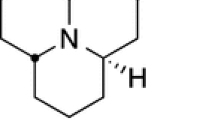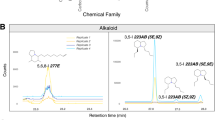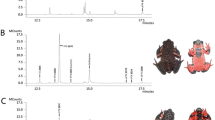Abstract
Bufonid poison frogs of the genus Melanophryniscus contain alkaloid-based chemical defenses that are derived from a diet of alkaloid-containing arthropods. In addition to dietary alkaloids, bufadienolide-like compounds and indolealkylamines have been identified in certain species of Melanophryniscus. Our study reports, for the first time, the co-occurrence of large quantities of both alkaloids sequestered from the diet and an endogenously biosynthesized indolalkylamine in skin secretions from individual specimens of Melanophryniscus moreirae from Brazil. GC/MS analysis of 55 individuals of M. moreirae revealed 37 dietary alkaloids and the biosynthesized indolealkylamine bufotenine. On average, pumiliotoxin 267C, bufotenine, and allopumilitoxin 323B collectively represent ca. 90 % of the defensive chemicals present in an individual. The quantity of defensive chemicals differed between sexes, with males possessing significantly less dietary alkaloid and bufotenine than females. Most of the dietary alkaloids have structures with branched-chains, indicating they are likely derived from oribatid mites. The ratio of bufotenine:alkaloid quantity decreased with increasing quantities of dietary alkaloids, suggesting that M. moreirae might regulate bufotenine synthesis in relation to sequestration of dietary alkaloids.



Similar content being viewed by others
References
Cei JM, Erspamer V, Roseghini M (1968) Taxonomic and evolutionary significance of biogenic amines and polypeptides in amphibian skin. II. Toads of the genera Bufo and Melanophryniscus. Syst Zool 17:232–245. doi:10.2307/2412002
Conlon JM (2011a) Structural diversity and species distribution of host-defense peptides in frog skin secretions. Cell Mol Life Sci 68:2303–2315. doi:10.1007/s00018-011-0720-8
Conlon JM (2011b) The contribution of skin antimicrobial peptides to the system of innate immunity in anurans. Cell Tissue Res 343:201–212. doi:10.1007/s00441-010-1014-4
Daly JW (1998) Thirty years of discovering arthropod alkaloids in amphibian skin. J Nat Prod 61:162–172. doi:10.1021/np970460e
Daly JW, Highet RJ, Myers CW (1984) Occurrence of skin alkaloids in non-dendrobatid frogs from Brazil (Bufonidae), Australia (Myobatrachidae) and Madagascar (Mantellinae). Toxicon 22:905–919. doi:10.1186/2193-1801-1-51
Daly JW, Myers CW, Whittaker N (1987) Further classification of skin alkaloids from neotropical poison frogs (Dendrobatidae), with a general survey of toxic/noxious substances in the amphibia. Toxicon 25:1023–1095. doi:10.1016/0041-0101(87)90265-0
Daly JW, Gusovsky F, McNeal ET, Secunda S, Bell M, Creveling CR, Nishizawa Y, Overman LE, Sharp MJ, Rossignol DP (1990) Pumiliotoxin alkaloids: a new class of sodium channel agents. Biochem Pharmacol 40:315–326. doi:10.1016/0006-2952(90)90694-G
Daly JW, Garraffo HM, Spande TF, Clark VC, Ma J, Ziffer H, Cover JF (2003) Evidence for an enantioselective pumiliotoxin 7-hydroxylase in dendrobatid poison frogs of the genus Dendrobates. Proc Natl Acad Sci U S A 100:11092–11097. doi:10.1073/pnas.1834430100
Daly JW, Spande TF, Garraffo HM (2005) Alkaloids from amphibian skin: a tabulation of over eight-hundred compounds. J Nat Prod 68:1556–1575. doi:10.1186/2193-1801-1-51
Daly JW, Wilham JM, Spande TF, Garraffo HM, Gil RR, Silva GL, Vaira M (2007) Alkaloids in bufonid toads (Melanophryniscus): temporal and geographic determinants for two Argentinian species. J Chem Ecol 33:871–887. doi:10.1007/s10886-007-9261-x
Daly JW, Garraffo HM, Spande TF, Yeh H, Peltzer PM, Cacivio P, Baldo D, Faivovich J (2008) Indolizidine 239Q and quinolizidine 275I. Major alkaloids in two Argentinian bufonid toads (Melanophryniscus). Toxicon 52:858–870. doi:10.1016/j.toxicon.2008.08.016
Erspamer V (1994) Bioactive secretions of the amphibian integument. In: Heatwole H, Barthalmus GT (eds) Amphibian biology. The integument. Surrey Beatty and Sons, pp 178–350
Flier J, Daly JW, Myers CW (1980) Widespread occurrence in frogs and toads of skin compounds interacting with the Ouabain site of Na, K-ATPase. Science 208:503–505. doi:10.1126/science.6245447
Frost DR (2014) Amphibian species of the world: an online reference. Version 6.0. American Museum of Natural History. http://research.amnh.org/herpetology/amphibia/index.html. Accessed 26 Nov 2014
Garraffo HM, Andriamaharavo NR, Vaira M, Quiroga MF, Heit C, Spande TF (2012) Alkaloids from single skins of the Argentinian toad Melanophryniscus rubriventris (Anura, Bufonidae): an unexpected variability in alkaloid profiles and a profusion of new structures. SpringerPlus 1:1–15. doi:10.1186/2193-1801-1-51
Grant T, Colombo P, Verrastro L, Saporito RA (2012) The occurrence of defensive alkaloids in non-integumentary tissues of the Brazilian red-belly toad Melanophryniscus simplex (Bufonidae). Chemoecology 22:169–178. doi:10.1007/s00049-012-0107-9
Hantak MM, Grant T, Reinsch S, Mcginnity D, Loring M, Toyooka N, Saporito RA (2013) Dietary alkaloid sequestration in a poison frog: an experimental test of alkaloid uptake in Melanophryniscus stelzneri (Bufonidae). J Chem Ecol 39:1400–1406. doi:10.1007/s10886-013-0361-5
Maciel NM, Schwartz CA, Rodrigues Pires Júnior O, Sebben A, Castro MS, Sousa MV, Fontes W, Ferroni Schwartz EN (2003) Composition of indolealkylamines of Bufo rubescens cutaneous secretions compared to six other Brazilian bufonids with phylogenetic implications. Comp Biochem Phys B 134:641–649. doi:10.1016/S1096-4959(03)00022-8
Mebs D, Pogoda W, Maneyro R, Kwet A (2005) Studies on the poisonous skin secretion of individual red bellied toads, Melanophryniscus montevidensis (Anura, Bufonidae), from Uruguay. Toxicon 46:641–650. doi:10.1016/j.toxicon.2005.07.004
Mebs D, Maneyro R, Pogoda W (2007a) Further studies on pumiliotoxin 251D and hydroquinone content of the skin secretion of Melanophryniscus species (Anura, Bufonidae) from Uruguay. Toxicon 50:166–169. doi:10.1016/j.toxicon.2007.02.017
Mebs D, Wagner MG, Pogoda W, Maneyro R, Kwet A, Kauert G (2007b) Lack of bufadienolides in the skin secretion of red bellied toads, Melanophryniscus spp. (Anura, Bufonidae), from Uruguay. Comp Biochem Phys C 144:398–402. doi:10.1016/j.cbpc.2006.11.009
Mina AE, Ponti AK, Woodcraft NL, Johnson EE, Saporito RA (2015) Variation in alkaloid-based microbial defenses of the dendrobatid poison frog Oophaga pumilio. Chemoecology. doi:10.1007/s00049-015-0186-5
Monnet JM, Cherry MI (2002) Sexual size dimorphism in anurans. Proc R Soc B-Biol Sci 269:2301–2307. doi:10.1098/rspb.2002.2170
R Core Team (2013) R: a language and environment for statistical computing. R Foundation for Statistical Computing, Vienna, http://www.R-project.org/
Rodríguez A, Poth D, Schulz S, Vences M (2010) Discovery of skin alkaloids in a miniaturized eleutherodactylid frog from Cuba. Biol Lett 7:414–418. doi:10.1098/rsbl.2010.0844
Saporito RA, Donnelly MA, Garraffo HM, Spande TF, Daly JW (2006) Geographic and seasonal variation in alkaloid-based chemical defenses of Dendrobates pumilio from Bocas del Toro, Panama. J Chem Ecol 32:795–814. doi:10.1007/s10886-006-9034-y
Saporito RA, Donnelly MA, Norton RA, Garraffo HM, Spande TF, Daly JW (2007) Oribatid mites as a major dietary source for alkaloids in poison frogs. Proc Natl Acad Sci U S A 104:8885–8890. doi:10.1073/pnas.0702851104
Saporito RA, Spande TF, Garraffo HM, Donnelly MA (2009) Arthropod alkaloids in poison frogs: a review of the “dietary hypothesis”. Heterocycles 79:277–297. doi:10.3987/REV-08-SR(D)11
Saporito RA, Donnelly MA, Madden AA, Garraffo HM, Spande TF (2010) Sex-related differences in alkaloid chemical defenses of the dendrobatid frog Oophaga pumilio from Cayo Nancy, Bocas del Toro, Panama. J Nat Prod 73:317–321. doi:10.1021/np900702d
Saporito RA, Norton R, Andriamaharavo NR, Garraffo HM, Spande TF (2011) Alkaloids in the mite Scheloribates laevigatus: further alkaloids common to oribatid mites and poison frogs. J Chem Ecol 37:213–218. doi:10.1007/s10886-011-9914-7
Saporito RA, Donnelly MA, Spande TF, Garraffo HM (2012) A review of chemical ecology in poison frogs. Chemoecology 22:159–168. doi:10.1007/s00049-011-0088-0
Savitzky AH, Mori A, Hutchinson DA, Saporito RA, Burghardt GM, Lillywhite HB, Meinwald J (2012) Sequestered defensive toxins in tetrapod vertebrates: principles, patterns, and prospects for future studies. Chemoecology 22:141–158. doi:10.1007/s00049-012-0112-z
Smith BP, Tyler MJ, Kaneko T, Garraffo HM, Spande TF, Daly JW (2002) Evidence for biosynthesis of pseudophrynamine alkaloids by an Australian myobatrachid frog (Pseudophryne) and for sequestration of dietary pumiliotoxins. J Nat Prod 65:439–447. doi:10.1021/np010506a
Stynoski J, Torres-Mendoza Y, Sasa-Marin M, Saporito RA (2014) Evidence of maternal provisioning of alkaloid-based chemical defenses in the strawberry poison frog Oophaga pumilio. Ecology 95:587–593. doi:10.1890/13-0927.1
Toledo R, Jared C (1995) Cutaneous granular glands and amphibian venoms. J Comp Physiol A 111:1–29. doi:10.1016/0300-9629(95)98515-I
Ujváry I (2014) Psychoactive natural products: overview of recent developments. Ann Ist Super Sanita 50:12–27. doi:10.4415/ANN
Vigerelli H, Sciani JM, Jared C, Antoniazzi MM, Caporale GMM, da Silva ADCR, Pimenta DC (2014) Bufotenine is able to block rabies virus infection in BHK-21 cells. J Venom Anim Toxins Incl Trop Dis 20:45. doi:10.1186/1678-9199-20-45
Weldon PJ, Cardoza YJ, Vander Meer RK, Hoffmann WC, Daly JW, Spande TF (2013) Contact toxicities of anuran skin alkaloids against the fire ant (Solenopsis invicta). Naturwissenschaften 100:185–192. doi:10.1007/s00114-013-1010-0
Acknowledgments
Fieldwork at Itatiaia National Park was conducted under license No. 41014-1. This study was supported by the Brazilian Conselho Nacional de Desenvolvimento Científico e Tecnológico (CNPq Proc. 307001/2011-3) and Fundação de Amparo à Pesquisa do Estado de São Paulo (FAPESP Procs. 2012/10000-5, 2013/14061-1, 2013/23715-5, and 2014/15730-7), John Carroll University (JCU), and a Kresge Challenge Grant awarded to JCU. We thank M.A. Nichols for his assistance in maintaining the GC/MS and J. Carvajalino-Fernández, R. Henrique, R. Montesinos, L. Nascimento, S. Pavan, M. Rada, M. Targino, and G.W. Tomzhinski for logistic support and assistance during fieldwork and help preparing samples.
Author information
Authors and Affiliations
Corresponding author
Rights and permissions
About this article
Cite this article
Jeckel, A.M., Grant, T. & Saporito, R.A. Sequestered and Synthesized Chemical Defenses in the Poison Frog Melanophryniscus moreirae . J Chem Ecol 41, 505–512 (2015). https://doi.org/10.1007/s10886-015-0578-6
Received:
Revised:
Accepted:
Published:
Issue Date:
DOI: https://doi.org/10.1007/s10886-015-0578-6




